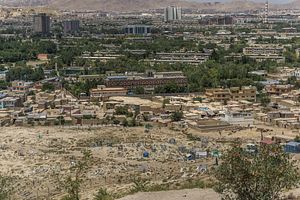Tuesday morning, around 9 am local time in Kabul, a vehicle-borne bomb was detonated outside the Afghan National Directorate of Security (NDS) building in the Pul-e-Mahmud neighborhood, killing at least 30 people and injuring 327. The attack, which occurred during morning rush-hour, was in a neighborhood that’s also home to the presidential palace, the defense ministry, several mosques, schools, and a football stadium.
The Taliban were swift to claim the attack, calling it part of their “Omari” spring offensive. The Taliban’s statement claims that three “martyrdom seekers” had succeeded in killing 92 “workers, key operatives, and security guards,” and that no civilians were killed; “Everyone is aware that no civilians are permitted to travel in close proximity to the 10th directorate building of the NDS and neither is this a civilian area.”
The Taliban’s account is more fiction than not, but provides a glimpse into the group’s internal logic. The Taliban has been quick, in the past, to distance itself from attacks incurring civilian casualties, but groups like the UN say that civilian casualties are at record levels. The UN Assistance Mission in Afghanistan which, among other tasks, monitors civilian casualties, said in February that the “number of civilian casualties in Afghanistan during 2015 are the highest recorded” and that 62 percent of all civilian casualties were caused by “anti-government elements.” So-called complex and suicide attacks, like Tuesday’s attack, have been on the rise.
The target–stated by the Taliban to be the “10th directorate intelligence building,” and by others to be a secret service unit tasked with protecting VIPs–was a prominent one for the Taliban. If it cannot disavow the attack–because the target is too lucrative–it has to deny the reality of the repercussions of blowing up trucks loaded with explosives in the center of populous cities.
According to the Afghan Ministry of the Interior, the majority of the casualties are civilians, including women and children. The chief of Kabul’s police told the AFP that one suicide attacker detonated a truck in a parking lot and “the second attacker engaged security forces in a gun battle before being gunned down,” he added.
The Taliban claim a third attacker not only “killed 58 intelligence agency operatives including key members all by himself,” but also escaped alive. This is, in all likelihood, an extreme exaggeration.
This is not Kabul’s first such attack and is unlikely to be the last.
The BBC had a sober assessment that bears repeating, noting that while the Taliban claims “successful” attacks ,“What we hear less of are similar planned attacks that are foiled by the Afghan security forces, and there are plenty”:
But preventing such attacks altogether is next to impossible.
The country has been at war for three decades, explosives are easily available and bomb-making skills are common.
The Taliban’s “spring offensive” is part of a propaganda war. The group fights all year round and so do the Afghan security forces. It is the story of the past 37 years.
The battle, in some ways, is one of narrative. If people trust their local media and government, the Taliban’s claims look more like the lies they are.
































